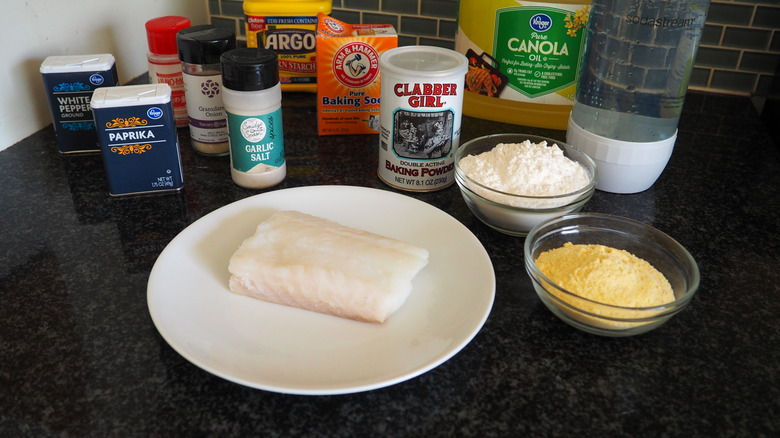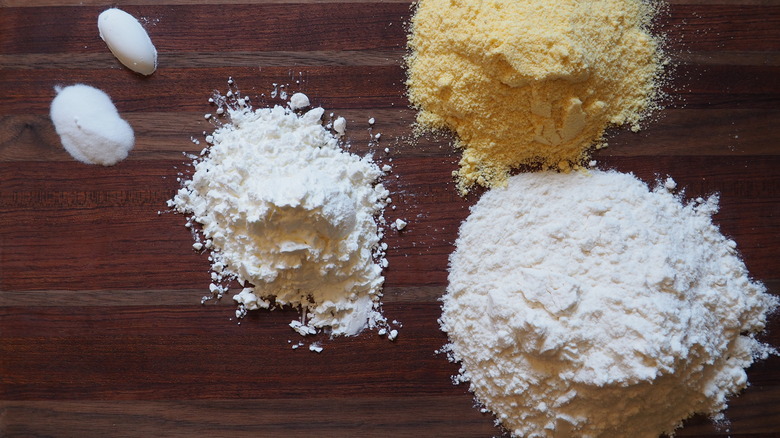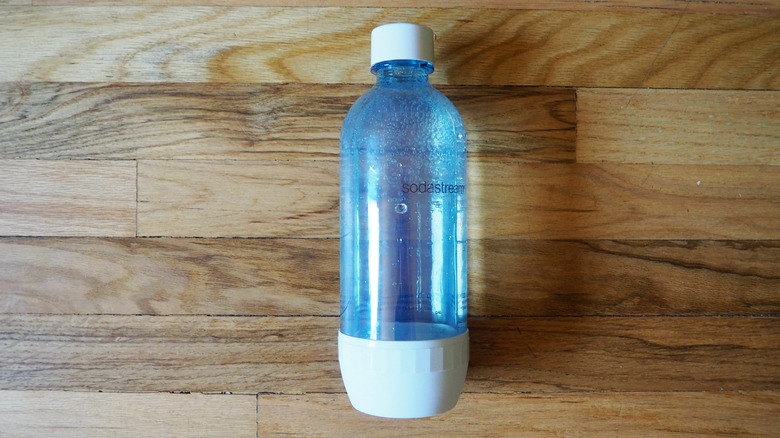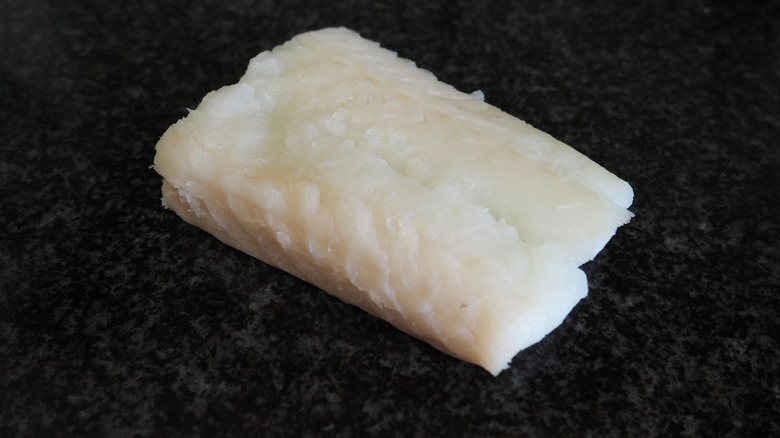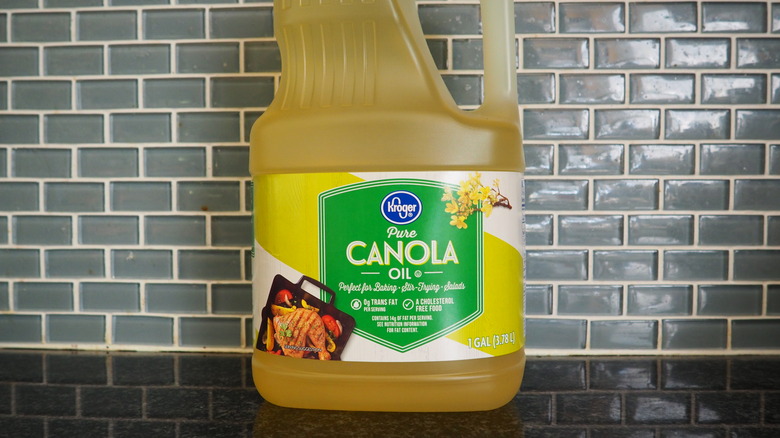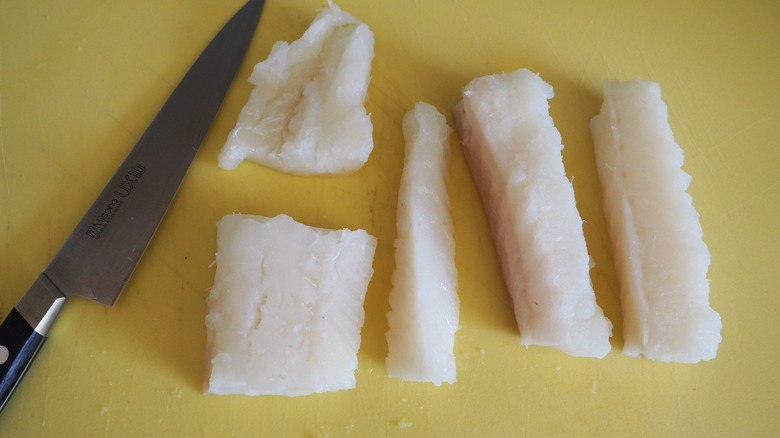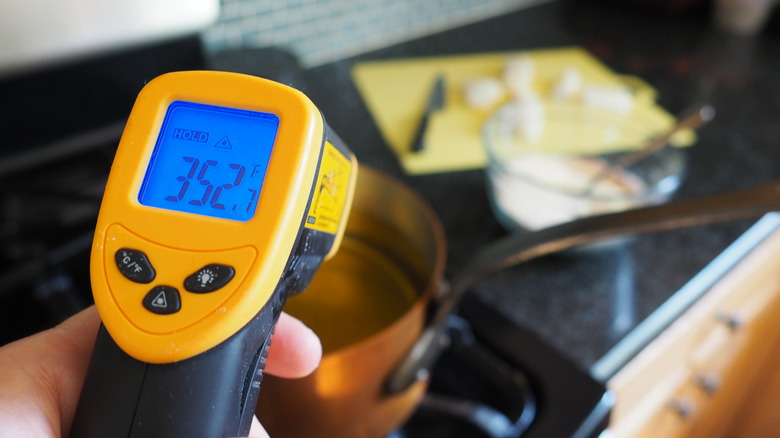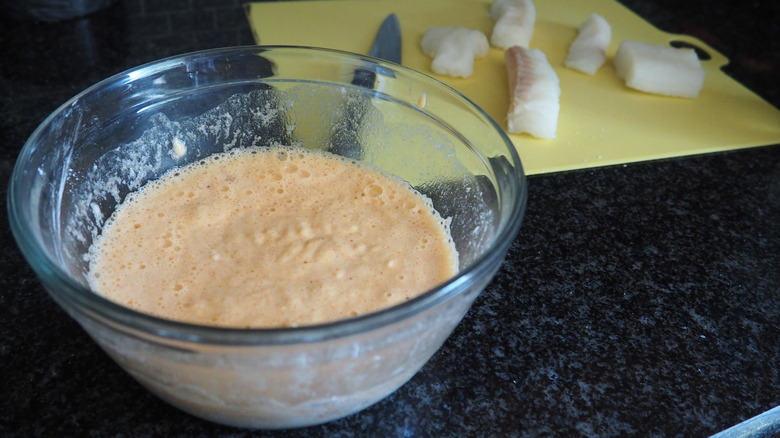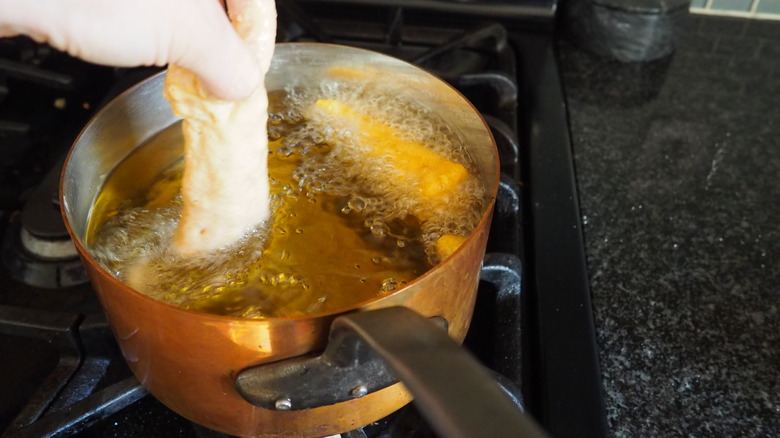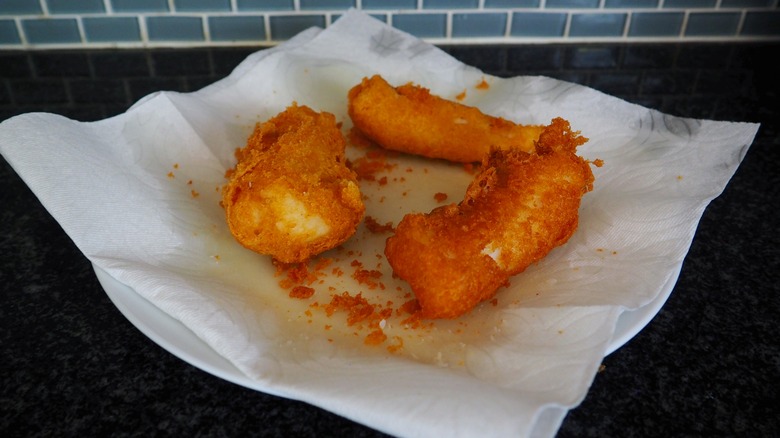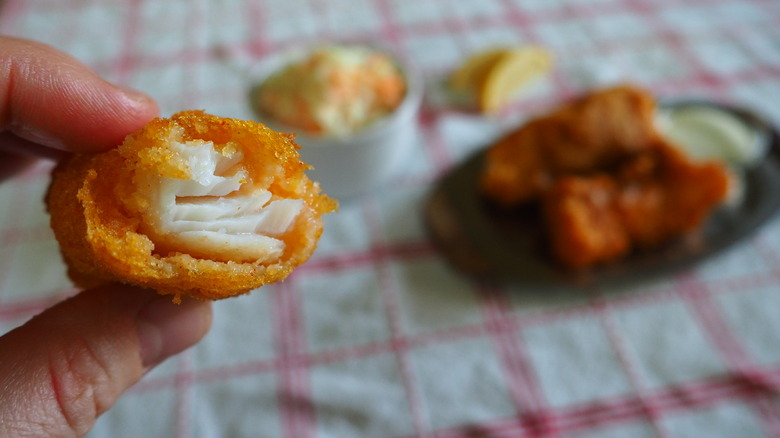Copycat Long John Silver's Fish Recipe
Once upon a time, an order of fish and chips was an exclusive seaside experience. Landlocked states like Kentucky or Colorado didn't have the luxury of fresh fish deliveries, but the visionaries behind restaurants like Long John Silver's changed that. In 1969, the first Long John Silver's opened in Lexington, Kentucky with a goal of making seafood experiences accessible to all. The chain quickly expanded around the country, to the delight of everyone who tried their crispy, batter-dipped fish.
Unfortunately, stories like these don't always have a happy ending. Long John Silver's is struggling; the menu isn't changing with the times, and they've been heavily criticized for serving unhealthy, trans-fat-laden fried food. To their credit, they made some ingredient swaps in the past years, committing to use 100% trans-fat-free soybean oil in 2014 (and later switching to pure canola oil in 2018). They've also added more grilled items to the menu, but it's hard to say if the chain will make it through their troubles.
Does that mean that their deliciously crunchy, diamond-shaped fish will be lost forever? Not if we can help it! We set out to make perfect Long John Silver's fish, and it's just as good — if not better — than the original.
Gather your ingredients for copycat Long John Silver's fish
There were a few obvious ingredients for this recipe, and a few we had to do some detective work to figure out. Long John Silver's is pretty transparent that they use canola oil as their fryer oil, so we didn't have to dig too deep to figure that one out. When it came to the fish, they use Alaska pollock for the triangle-shaped two-piece fish meal and Pacific cod for the Classic Cod meal. It's definitely easier to find cod (and it's more sustainable, according to the Monterey Bay Aquarium Seafood Watch), so we went that route.
Then came the detecting stage: Long John Silver's ingredient statement lists several items in the batter. Some of them were pretty straightforward: wheat flour, corn flour, corn starch, paprika, garlic powder, MSG, and leavening (baking soda and baking powder). After a taste test, we added in onion powder and white pepper to account for the "spices" on the ingredients list. To finish the batter, we added a cup of cold club soda to the mix.
Find the full ingredients list and step-by-step instructions at the end of this article.
What's in the breading for Long John Silver's fish?
The breading for Long John Silver's fish is what makes the cod taste so good, but it's not actually a breading. Many fried food recipes (like Chick-fil-A chicken nuggets) use a process called dredging, where you dip the food in an egg or milk bath before coating it in seasoned flour. Long John Silver's fish uses a batter, which is a mixture of wet and dry ingredients.
The recipe here is a classic batter for fish and chips. Some recipes contain eggs (and are known as tempura), while others contain beer (you guessed it — beer batter). Long John Silver's contains neither. It gets its light and crispy texture from a combination of two types of flour: all-purpose flour and corn flour. Corn flour is different from cornmeal and corn starch, and you'll likely have to take a trip to the grocery store to get it. It's worth the outing, though; it adds the perfect boost of natural sweetness to the fish.
Finally, there's the cornstarch, baking powder, and baking soda. The cornstarch is an essential ingredient in creating a crispy texture, and it also helps the exterior reach a perfect golden-brown color. The baking powder and baking soda, in conjunction with the soda water, create tiny air bubbles that keep an otherwise heavy fried food tasting light.
What's up with the soda water in Long John Silver's fish?
Using soda water instead of regular water might seem odd, but trust us; it's an essential ingredient. The secret to creating a light and crispy batter (just like Long John Silver's) is all about creating air bubbles. Some recipes do this by using baking powder or baking soda alone. When these leavening agents encounter the heat of fryer oil, a chemical reaction occurs that creates carbon dioxide. That creates tiny little pockets of air in the batter. The result is a light and fluffy breading for fish.
The other way to create air bubbles is to use a liquid that already contains carbon dioxide. This is the primary reason that many fish and chips recipes use a beer batter. Long John Silver's doesn't use beer in their batter, but they may use club soda, an ingredient used in many tempura batter recipes. The bubbles will go away as you mix, so you'll want to mix lightly. But, that's a good idea anyway, as overmixing a batter for seafood (like tempura) can make it heavy. You can use any type of bubbly water you like, including club soda and seltzer water. We used a Soda Stream to create our own bubbles at home, and it worked just fine.
The perfect Long John's Silver fish is made with wild-caught cod
Long John Silver's has received some pretty bad press over the years, including the 2013 story that the "Big Catch" is the worst restaurant meal in America. Part of the company's rebranding strategy includes its commitment to sourcing sustainable, wild-caught fish. In 2016, the company's vice president of media, promotions, and marketing told Undercurrent News that they only use 100% wild-caught cod and pollock, which they pull straight out of "the cold water in Alaska."
If you can, you should follow Long John Silver's lead when shopping for fish for this recipe. Look for fish called "Alaskan cod" or "Pacific cod." If it doesn't specifically say wild-caught on the label, it's not. Wild-caught cod has more nutritional value than farmed cod because they eat a natural diet. It's also considered a sustainable fish by the Monterey Bay Aquarium Seafood Watch, so it will not only taste great, but you can feel good about your impact on the environment, too.
Long John Silver's uses 100% pure canola oil
Okay, one last note about the ingredients before we move onto cooking our Long John Silver's fish. You can use several different types of cooking oils when frying food. Since we're frying our fish at 350 degrees Fahrenheit, you could use any oil with a smoke point above 400 degrees (the temperature at which the oil starts to smoke and break down). That includes options like canola oil, vegetable oil, corn oil, peanut oil, or safflower oil.
We chose to use canola oil for this recipe because it's what the chain uses. On their list of ingredients, Long John Silver's shares that they proudly use 100% pure canola oil. They have a huge boost in business during Lent, and they wanted to respect Catholic Lenten customs and provide a meal on Friday that is free of meat. According to Business Insider, several fast-food restaurants fry their fish products in beef oil, which could be a concern for people observing Lent.
Prepare the fish to become copycat Long John Silver's fish
It's time to get cooking! Our first step in preparing Long John Silver's fish is to work with the fish itself. If you bought frozen fish (which was the case for us), you'll want to start by defrosting it. Remove the fish from any plastic or vacuum-sealed packages before thawing. This exposes the fish to oxygen and prevents the growth of bacteria like botulism. Place the fish on a plate and cover it lightly with plastic wrap, and place it in the fridge. After about 12 hours, the fish should be ready to cook. It will be very wet, so you'll want to dry it well with paper towels to help the batter adhere in the later steps.
The serving size of Long John Silver's battered cod is 85 grams per piece, or about three ounces, so you'll need to cut yours down to size. If you don't have a scale, this amount looks like the palm of your hand. You can cut the fish into larger chunks if you like, but it can sink in the fryer if it's too heavy. If it sticks to the bottom of the pan, it won't have a perfect breading, and clean-up will become that much more annoying. It's really difficult to get the cod into triangle-shaped pieces. Maybe it's easier if you buy pollock, but our cod wanted to naturally separate into long strips, so we went with it. Don't stress it too much; the fish will taste great, even if it's the wrong shape.
Heat the canola oil to fry the copycat Long John Silver's fish
You might think the next step would be to prepare the breading, but we recommend heating the oil first. It's best to prepare the batter just before you fry, so the oil needs to be hot and ready. Give yourself some time to get set up, because it can take 5 to 10 minutes for the oil temperature to reach 350 degrees Fahrenheit, a temperature that will cook your fish evenly inside and out.
If you're using an electric fryer, this part is pretty easy. Fill the fryer to the MAX line and set the temperature to 350 degrees. When it reaches the proper temps, the fryer will automatically reduce the heat to hold the oil at a steady temperature.
You can also deep fry in a Dutch oven or a wok. To do that, add about three inches of oil (somewhere between four and six cups) to the pot and turn the heat on medium-high. Use a deep-frying thermometer to monitor the temperature of the oil. When it hits 350 degrees, reduce the heat to medium or low while you prepare the fish batter.
Make the batter for copycat Long John Silver's fish
We know that Long John Silver's probably prepares their batter in the morning and uses it all day long, but homemade fish and chips really taste best with fresh batter. According to Epicurious, tempura batter is best when it's prepared just before frying. Making it ahead of time can make the fish breading heavy. Since Long John Silver's fried fish is light and crispy, we wanted to do everything we could to replicate it.
Grab a medium-sized bowl and mix together all the dry ingredients. Once they're well combined, grab a whisk and get ready to add the club soda. As soon as you start pouring it in, it will react with the dry mix, foaming up and creating large bubbles, so you'll want to stir as you go to prevent it from overflowing over the side of the bowl. Gently mix until all the dry ingredients are moistened by the soda. Don't try to mix the batter until it's smooth — it's okay if there are a few clumps — because overmixing can make the batter heavy.
Dip and fry your copycat Long John Silver's fish
Now that the batter is ready, it's time to start frying. Grab a piece of fish and dunk it into the batter. The batter should be fairly thick, and you'll need to turn the fish over a few times to get it fully coated. After you can see batter on all sides of the fish fillet, pluck it out of the bowl using your fingers and let the excess drain off.
Now, here comes the tricky part. You don't want to get your fingers close to the hot fryer oil because it can burn your hands badly if there is any splatter. If you're inexperienced at frying, we suggest grabbing a pair of tongs for this part. Dangle an inch or so of the battered fish into the hot oil, waving it back and forth. This starts frying the edge of the fish, inflating it with all those air bubbles we talked about earlier. After about 30 seconds, gently drop the rest of the fish into the oil. The partially fried edge will help the fish float in the oil.
Fry the fish for 3 to 5 minutes, until it's golden brown on all sides. Depending on the size of your fryer, you may not be able to fit all the fish into the fryer at once. If you are frying in batches, make sure to let the oil come all the way back up to 350 degrees Fahrenheit before adding the next batch of fish.
Transfer your copycat Long John Silver's fish
When the fish is golden brown on all sides, it's almost ready to eat. The only step that remains is to transfer it to a paper towel-lined plate. When the fish is finished cooking, it's coated in excessive amounts of oil from the fryer. The easiest way to blot off the extra oil is to let the fish drain for a minute or two on a plate lined with paper towels. Sprinkle the fish with kosher salt to add a little extra seasoning to your Long John Silver's fish.
If you need to fry a second batch of fish, we recommend swapping in a baking sheet lined with an oven-safe rack instead of the paper towels. As the fish sit on a plate, the bottom of the breading can become a little soggy. Elevating the fish onto a rack is a great way to keep airflow underneath the fish, keeping it as crispy as possible. If you are frying multiple batches of fish, you can also hot-hold the fish in a 200 degree Fahrenheit oven for up to ten minutes.
How close did we get to the original?
We got really, really close on this one. The fish inside was juicy and tender, and the batter outside was light, airy, and crispy — just like Long John Silver's. It had the perfect level of spice from the paprika and white pepper, and the garlic and onion powders gave it a savory finish. Some of our tasters even thought our batter tasted better than the fast-food restaurant's (and one said it reminded him of how Long John's was back in the day).
The one place where Long John Silver's definitely had us was the shape. We cut most of our fish into long strips, with a few pieces in square-ish shapes. None of them had the characteristic triangle shape, which didn't affect the flavor but it did affect presentation. Our fish pieces were also thicker than Long John Silver's. The next time around, we might try to fillet our cod pieces in half to give them an improved batter-to-fish ratio.
All in all, we loved this recipe, and we'll definitely make it again. The batter was so good, we're tempted to use it for everything: chicken, popcorn shrimp, or even vegetables.
Copycat Long John Silver's fish directions
We set out to make perfect Long John Silver's fish, and it's just as good — if not better — than the original. Try it out yourself at home.
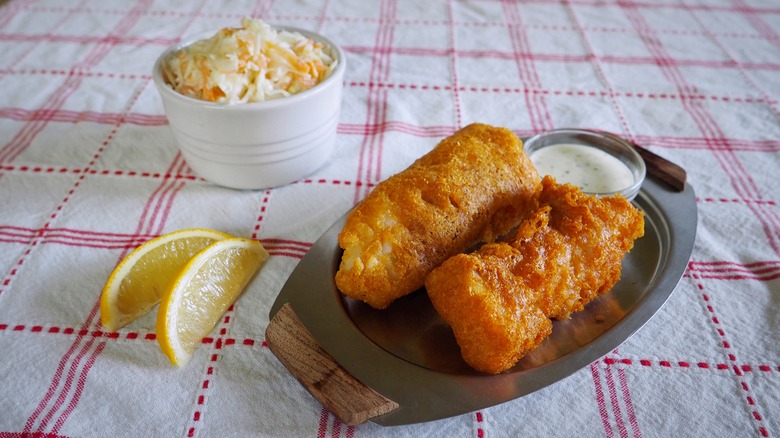
Ingredients
- Canola oil (for frying)
- 3/4 pound frozen cod, thawed
- 1/2 cup all-purpose flour
- 1/4 cup corn flour
- 2 tablespoons cornstarch
- 1/2 teaspoon MSG
- 1/2 teaspoon paprika
- 1/2 teaspoon garlic salt
- 1/2 teaspoon onion powder
- 1/2 teaspoon white pepper
- 1/4 teaspoon baking powder
- 1/4 teaspoon baking soda
- 1 cup cold club soda
- Kosher salt, to taste
Directions
- In a large Dutch oven, heat 3 inches of oil. If you're using an electric tabletop fryer, fill the unit to its MAX line.
- Preheat the oil to 350 degrees over medium-high heat, using a deep-frying thermometer to check the temperature. When the oil reaches 350 degrees, reduce the heat to medium-low.
- Meanwhile, pat the fish dry with a paper towel and cut the fish into four 3-ounce portions. If you like, you can create a diamond shape by trimming off the sides. Set aside.
- In a medium-sized bowl, combine the flour, corn flour, cornstarch, MSG, paprika, garlic salt, onion powder, white pepper, baking powder, and baking soda.
- When the oil is preheated and ready to go, add the club soda to the dry batter mixture. Stir until just combined, taking care not to overmix. It's okay if there are a few clumps in the batter.
- Dip the fish into the batter, making sure it's coated on all sides. Gently drop the battered fish into the oil and fry for 3 to 5 minutes, until the exterior is golden brown.
- Remove the fish to a paper towel-lined plate to remove excess grease. Season the fish with kosher salt, to taste.
- Serve immediately.
Nutrition
| Calories per Serving | 807 |
| Total Fat | 54.4 g |
| Saturated Fat | 4.2 g |
| Trans Fat | 0.2 g |
| Cholesterol | 73.1 mg |
| Total Carbohydrates | 44.0 g |
| Dietary Fiber | 2.3 g |
| Total Sugars | 0.2 g |
| Sodium | 928.6 mg |
| Protein | 35.1 g |
